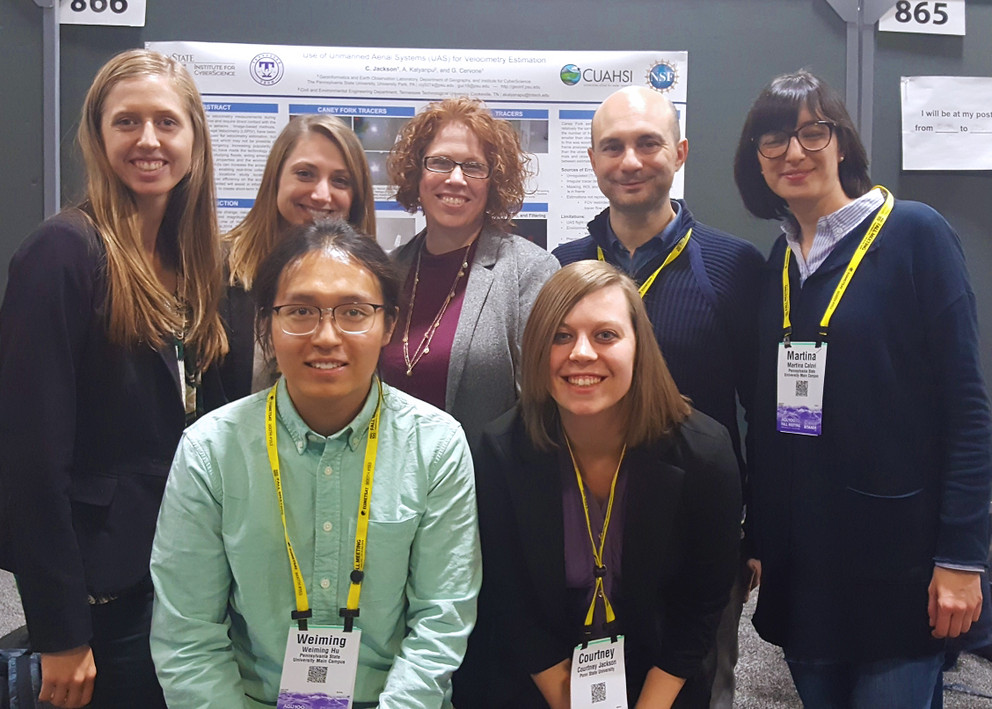
Guido Cervone with students and postdoctoral scholars from his lab at a recent AGU fall meeting. Front, left to right: Weiming Hu and Courtney Jackson. Back, left to right: Carolynne Hultquist, Elena Sava, Laura Clemente-Harding, Guido Cervone, Martina Calovi. IMAGE: PENN STATE
Cervone elected to lead AGU natural hazards section
Posted on January 8, 2021–By Angela Rogers
Penn State News
UNIVERSITY PARK, PA. — Guido Cervone, associate director of the Institute for Computational and Data Sciences, professor of geography, meteorology and atmospheric science and Earth and Environmental Systems Institute (EESI) associate, was elected as president-elect of the Natural Hazards Section of the American Geophysical Union (AGU) and begins a two-year term as president-elect on Jan. 1, 2021, and a two-year term as president on January 1, 2023.
Cervone’s background is in computational science and remote sensing. He directs the Geoinformatics and Earth Observation Laboratory in the Department of Geography, which focuses on the development and application of computational algorithms for the analysis of spatio-temporal remote sensing; numerical modeling; and social media big data related to environmental hazards and renewable energy.
Cervone has been actively involved in AGU and the Natural Hazards Section since 2004, serving on the fall meeting program committee for Natural Hazards; as chair for late-breaking sessions; and as co-chair for Human Geosciences and Natural Hazards for the joint meeting with the Japanese Geophysical Union.
“The AGU fall meeting is my primary conference,” Cervone said. “I became involved with the leadership of AGU because of Ramesh Singh, a former AGU Natural Hazards president, who suggested that I participate in committees and run for office. It was Singh and my adviser, Menas Kafatos, who introduced me to AGU when I was a Ph.D. student. So, I try to continue their legacy by bringing my entire laboratory to AGU every year.”
Singh, who was on Cervone’s doctoral committee and has co-authored several research papers with him using satellite data, said he was happy to see a young person as president-elect of Natural Hazards Section of AGU which has more than 60,000 members around the globe.
“Now, we cannot live without satellite data,” Singh said. “Guido’s passion for the ocean and data mining will bring an added advantage to understand coupling associated with earthquakes to develop tools for community to get an alert, to save life from all the natural hazards occurring throughout the world. I wish him a successful term as president-elect and full president of Natural Hazards Section during 2023-24.”
As the Natural Hazards Section encapsulates all the AGU disciplines, it brings together Cervone’s scholarly interests and a way to advance his leadership goals, which include promoting advanced computational analysis, enhancing global cooperation, and diversifying the scientific culture, he said.
“First, every year several catastrophic natural hazards strike somewhere on Earth and cause deaths and damage to properties and to the environment,” Cervone said. “That is a fundamental challenge for the survival of our civilization.”
In addition to that, the study of natural hazards fosters international collaboration and opportunities to partner among government, nongovernmental organizations, academe and industry, which Cervone said he plans to expand.
“Finally, it is one of my central goals to promote a very inclusive and balanced scientific culture and address the challenges that, especially, young scholars face as they undertake their scientific endeavors,” Cervone said.
“It is a huge honor for me to be elected for office by my peers,” Cervone said. “Serving in a leadership role I can help plan how to best showcase results and disseminate science, and facilitate building connections among the community, with the public, and with funding agencies. It is hoped that our work saves lives.”
Established in 1919 by the National Research Council, AGU is an international nonprofit association supporting an inclusive community of Earth and space scientists and partners dedicated to discovery and solutions to societal challenges.
